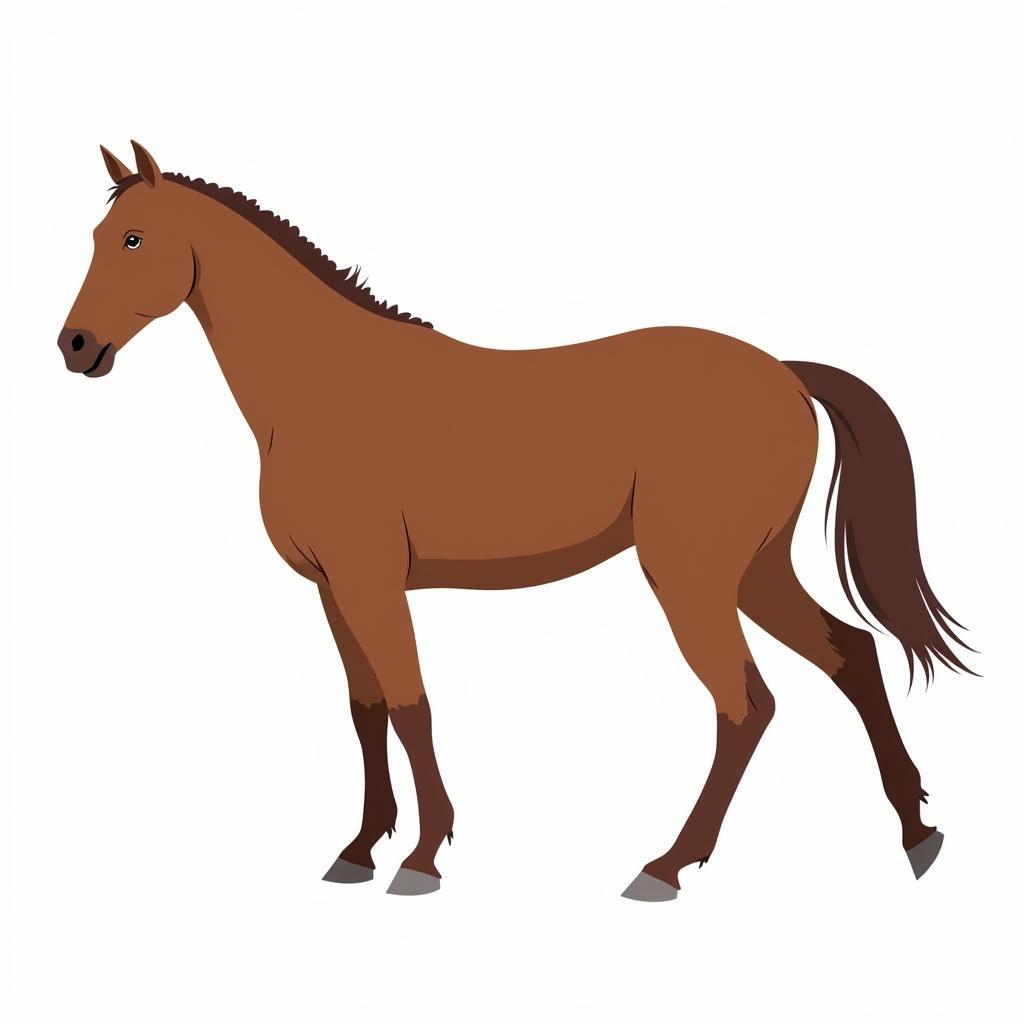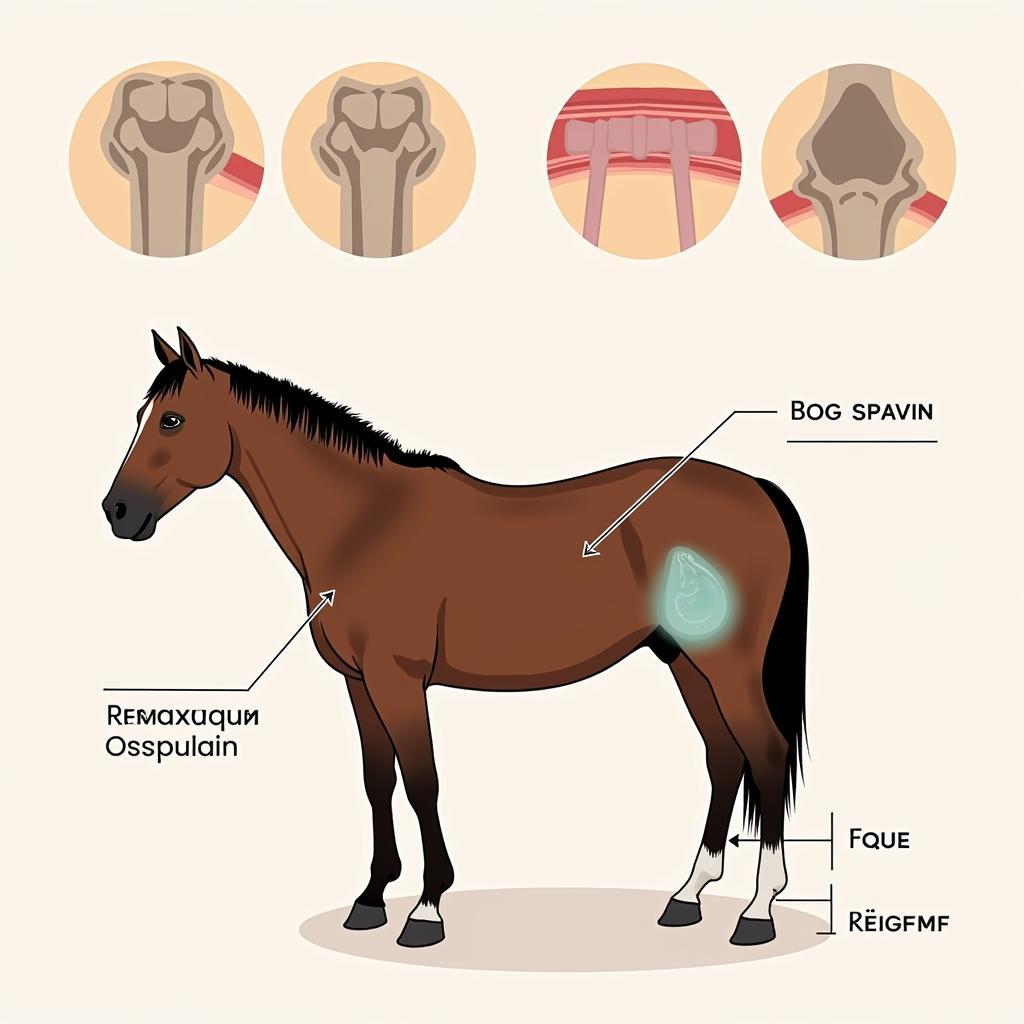A spavin horse is one suffering from osteoarthritis in the hock joint, located in the hind leg. This debilitating condition can cause lameness, pain, and stiffness, impacting the horse’s performance and overall well-being. Understanding spavin, its causes, symptoms, and treatment options is crucial for any horse owner.
Understanding Bone Spavin in Horses
Bone spavin, also known as true spavin or jack spavin, specifically refers to osteoarthritis affecting the lower hock joints. These joints are responsible for a significant portion of the horse’s hind leg movement and bear considerable weight. The degenerative process involves the breakdown of cartilage and the formation of bone spurs, leading to pain, restricted movement, and lameness.
Several factors can contribute to bone spavin, including conformation flaws like cow hocks or sickle hocks, repetitive stress from strenuous activity, poor shoeing practices, and traumatic injury. Horses used for jumping, dressage, and other high-impact disciplines are particularly susceptible.
“Early diagnosis and appropriate management are essential for minimizing the long-term effects of spavin,” advises Dr. Emily Carter, DVM, specializing in equine sports medicine. “Ignoring the signs can lead to irreversible joint damage and chronic lameness.”
Recognizing the Signs: Hock Pain in Horses Symptoms
Early signs of bone spavin can be subtle and easily missed. Often, the first noticeable symptom is intermittent lameness, especially after exercise or on hard ground. As the condition progresses, the lameness becomes more consistent. Other hock pain in horses symptoms include stiffness in the hock, swelling around the joint, a shortened stride, and reluctance to perform certain movements.
 Horse exhibiting lameness in hind leg due to spavin
Horse exhibiting lameness in hind leg due to spavin
Sometimes, the horse may drag the toe of the affected leg, which can cause excessive wear on the hoof. Detecting these subtle changes requires careful observation and a thorough understanding of the horse’s normal gait and behavior.
Bog Spavin: A Different Kind of Hock Problem
Another condition affecting the hock joint is bog spavin, which refers to distension of the joint capsule due to excessive synovial fluid. Unlike bone spavin, bog spavin doesn’t always cause lameness and is more of a cosmetic concern unless accompanied by other joint issues.
 Swelling in the horse's hock due to bog spavin
Swelling in the horse's hock due to bog spavin
While a post-legged conformation can make a horse more prone to developing both bog and bone spavin, you can learn more about this specific conformation on our post legged horse page. Understanding the differences and similarities between these two conditions is vital for accurate diagnosis and effective treatment.
Diagnosis and Treatment of Spavin
Diagnosing bone spavin typically involves a physical examination, lameness evaluation, and diagnostic imaging such as X-rays or ultrasound. These procedures allow veterinarians to assess the extent of joint damage and rule out other potential causes of lameness in the hind legs, as detailed in our article on lameness in hind legs of horses.
Treatment options vary depending on the severity of the spavin. Conservative approaches may include rest, controlled exercise, non-steroidal anti-inflammatory drugs (NSAIDs), and corrective shoeing. In some cases, horse braces may provide additional support. More advanced cases might require joint injections with corticosteroids or hyaluronic acid. Surgical options are also available, although they are less common.
“Finding the right treatment approach requires a collaborative effort between the horse owner, veterinarian, and farrier,” explains John Miller, a certified farrier with over 20 years of experience. “A comprehensive treatment plan addresses the individual needs of each horse and aims to manage pain, improve mobility, and prevent further joint deterioration.”
Conclusion: Managing Spavin for a Healthier Horse
A spavin horse can lead a productive and comfortable life with appropriate management. Understanding the different types of spavin, recognizing the symptoms, and seeking timely veterinary care are crucial for managing this condition effectively. By working closely with your veterinarian and farrier, you can develop a tailored treatment plan to minimize pain, maintain mobility, and ensure your horse’s long-term well-being. Remember, early intervention is key to minimizing the impact of spavin on your horse’s life.
FAQ
- What is the difference between bog spavin and bone spavin?
- Can a horse with spavin be ridden?
- What are the long-term effects of untreated spavin?
- What can I do to prevent spavin in my horse?
- How is spavin diagnosed?
Need help with your horse? Contact us! Phone: 0772127271, Email: [email protected] or visit us at QGM2+WX2, Vị Trung, Vị Thuỷ, Hậu Giang, Việt Nam. We have a 24/7 customer support team.